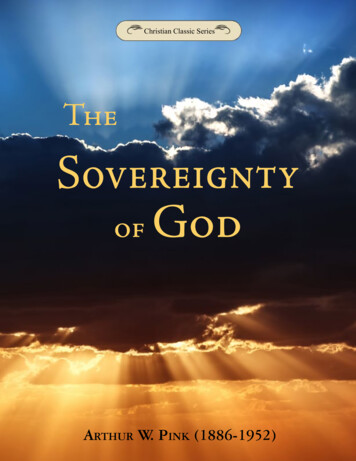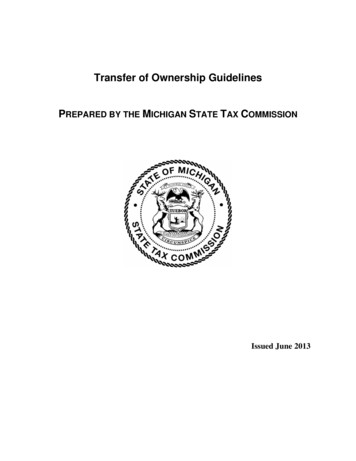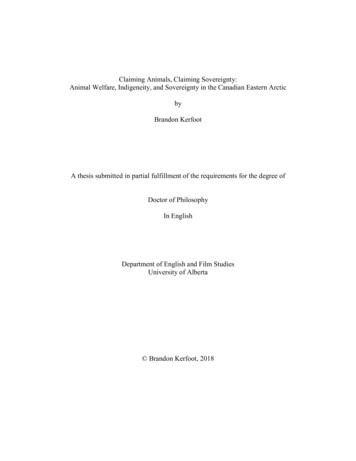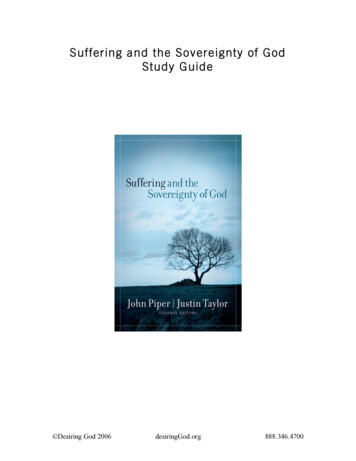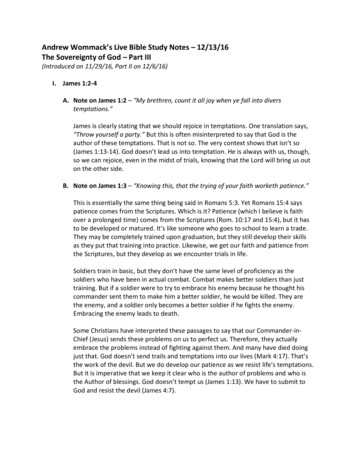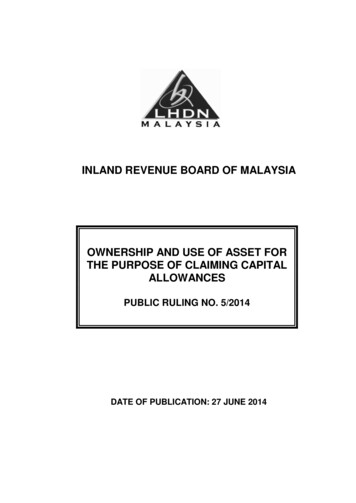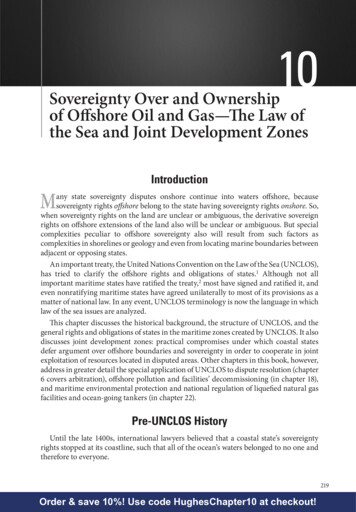
Transcription
10Sovereignty Over and Ownershipof Offshore Oil and Gas—The Law ofthe Sea and Joint Development ZonesMIntroductionany state sovereignty disputes onshore continue into waters offshore, becausesovereignty rights offshore belong to the state having sovereignty rights onshore. So,when sovereignty rights on the land are unclear or ambiguous, the derivative sovereignrights on offshore extensions of the land also will be unclear or ambiguous. But specialcomplexities peculiar to offshore sovereignty also will result from such factors ascomplexities in shorelines or geology and even from locating marine boundaries betweenadjacent or opposing states.An important treaty, the United Nations Convention on the Law of the Sea (UNCLOS),has tried to clarify the offshore rights and obligations of states.1 Although not allimportant maritime states have ratified the treaty,2 most have signed and ratified it, andeven nonratifying maritime states have agreed unilaterally to most of its provisions as amatter of national law. In any event, UNCLOS terminology is now the language in whichlaw of the sea issues are analyzed.This chapter discusses the historical background, the structure of UNCLOS, and thegeneral rights and obligations of states in the maritime zones created by UNCLOS. It alsodiscusses joint development zones: practical compromises under which coastal statesdefer argument over offshore boundaries and sovereignty in order to cooperate in jointexploitation of resources located in disputed areas. Other chapters in this book, however,address in greater detail the special application of UNCLOS to dispute resolution (chapter6 covers arbitration), offshore pollution and facilities’ decommissioning (in chapter 18),and maritime environmental protection and national regulation of liquefied natural gasfacilities and ocean-going tankers (in chapter 22).Pre-UNCLOS HistoryUntil the late 1400s, international lawyers believed that a coastal state’s sovereigntyrights stopped at its coastline, such that all of the ocean’s waters belonged to no one andtherefore to everyone.219Order & save 10%! Use code HughesChapter10 at checkout!
Fundamentals of International Oil and Gas LawSoon evident, however, was that coastal states had vital interests in controlling theircoastal waters to prevent smuggling and attack. An international consensus developedthat coastal states had sovereignty rights to territorial seas offshore, but lacking was anyconsensus as to how far from the coast the territorial seas extended or how to measurethe width of the territorial seas where the coast had irregularities like islands and bays.When technical advances after 1950 made exploitation of seabed minerals, including oiland gas, possible, defining a coastal state’s rights to seabed and subsoil of offshore areas(as well as to the waters of offshore areas) then became practical and urgent.Maritime states made various efforts to come to agreement on such issues, makingsome progress in 1958 in UN-sponsored treaties called Geneva Conventions.3 Butcomprehensive agreement on many issues came only in 1982, when approximately135 countries (including what is now the European Union) signed the United NationsConvention on the Law of the Sea (UNCLOS).The UNCLOS Water and Seabed ZonesAmong other things, UNCLOS establishes various zones for offshore waters; it alsoseparately establishes zones for offshore seabed and subsoil.4 While there exist generalcorrespondence between the water zones and the seabed zones in some cases, in othercases they do not correspond at all. The treaty allocates to states the sovereign rights andobligations within each of the zones with regard to transit, regulatory and enforcementjurisdiction, control of natural resources such as oil and gas, and environmentalprotection. The treaty also deals with marine boundaries and settlement of marineboundary disputes.Figure 10–1 shows the zones of waters and seabed.The baseline is the line from which the treaty defines or measures various zones ofwaters and seabed. The baseline runs along each coast and corresponds generally tothe coastline’s low-tide mark. But the baseline is subject to special rules dealing withcoastlines and such complexities as islands, archipelagos, large bays, adjacent or opposingcoastal states, and historical claims (fig. 10–2).5With regard to the zones of waters defined or measured in reference to the baseline,waters located on the land side of the baseline are referred to as a coastal state’s internalwaters. The internal waters include not only freshwater bodies like lakes and rivers, butalso bays located on the land side of the baseline.6 A canal such as the Suez Canal in Egyptlies within the land boundaries of its country and so may be thought of as internal waters.From the baseline and moving seaward, UNCLOS then establishes a series of furtherzones of waters located above the seabed and subsoil, with each water zone having legalconsequences for the coastal and noncoastal states. The territorial sea is the initial widthof sea or ocean, measured from the baseline and extending 12 nautical miles (NM)seaward.7 The contiguous zone is a second and further 12-mile-wide zone of watersas measured from the outer boundary of the territorial sea. (The treaty is somewhatconfusing here regarding measurement.) The exclusive economic zone (EEZ) extends220Order & save 10%! Use code HughesChapter10 at checkout!
Chapter 10Sovereignty Over and Ownership of Offshore Oil and Gas—The Law of the Sea and Joint Development Zonesseaward from the territorial sea, but measurement of the EEZ’s 200 NM width is madefrom the baseline.8 Finally, the high seas are waters beyond the outer limit of the EEZ.Fig. 10–1. UNCLOS zone scheme.*Although the EEZ and Continental Shelf extend seaward from the outer edge of the territorial sea, thedistance of the extension is measured from the baselineExamples of Coastline ComplexitiesAdjacent CoastlinesABOpposing CoastlinesAAAAABIsland(s)Historical ClaimsBIndented CoastlinesAAABFig. 10–2. Coastal zones create complex borders for countries.221Order & save 10%! Use code HughesChapter10 at checkout!
Fundamentals of International Oil and Gas LawIn addition to establishing this series of zones of waters, UNCLOS also establisheszones of seabed and subsoil below the waters. UNCLOS gives no special name to theseabed and subsoil below the territorial sea, but the continental shelf consists of theseabed and subsoil under the waters extending from the land and beyond the territorialsea in a seaward direction. Article 76 defines the continental shelf in geological terms, butsubject to complex minimum and maximum criteria and subject to adjustment by reasonof boundary rights of opposing and adjacent states: The continental shelf is the seabedand subsoil of the land extending “to the outer edge of the [submerged] continentalmargin,” but not less than 200 NM as measured from the baseline. If the outer edge ofthe submerged prolongation of the geologic continental margin extends more than 200NM from the baseline, then the continental shelf as defined in the treaty may exceed the200 NM (but not exceed a maximum generally consisting of 350 NM), to points definedin terms of the thickness of sedimentary rock relative to the foot of the continental slope,the change in gradient at the base of the slope, and water depth.9 It is evident, then, thatat least to the extent the continental shelf does not exceed 200 NM from the baseline, thecontinental shelf is that portion of the seabed and subsoil generally corresponding to theEEZ of the waters above. But continental shelves extending more than 200 NM from thebaseline are not unusual. In the Gulf of Mexico, for example, the US continental shelfextends beyond the 200 NM limit of the EEZ.The Area is the deep seabed, ocean floor, and subsoil beyond the continental shelf.Thus it is evident that the Area is the zone of seabed and subsoil generally correspondingto the water zone of high seas above it, except where the continental shelf extends beyondthe 200 NM minimum as measured from the baseline, the high seas may actually beginover some part of the continental shelf rather than over the Area.States’ Rights and Obligations within the ZonesIn addition to defining the different zones of waters and seabed relative to the baseline,the treaty tries to allocate rights and obligations of states within each of those zones. Inaddition, UNCLOS (or customary international law) addresses several other categoriesof waters or facilities (canals, ports, and straits) usually present in or through variouszones. Discussions in the following sections summarize, zone by zone, states’ rightsand obligations regarding transit, regulatory and enforcement jurisdiction, oil and gasexploration and production, placement of facilities, and environmental protection.UNCLOS Zone: Issue Analysis1. Transit of vessels2. Regulatory and enforcement jurisdiction3. Oil and gas exploration and production4. Construction of facilities5. Environment protectionWithin a coastal state’s internal waters. A state generally has and may exercise fullsovereignty rights over its internal waters (and seabed and subsoil under the internal222Order & save 10%! Use code HughesChapter10 at checkout!
Sovereignty Over and Ownership of Offshore Oil and Gas—The Law of the Sea and Joint Development ZonesChapter 10waters) as if the internal waters were its own land territory. Thus, a state generally hasunrestricted sovereignty to determine whether it will authorize transit across its internalwaters, is free to determine the legal regime for exploration and production, and mayregulate the placement of facilities and environmental protection concerning its internalwaters.10 Of course, a sovereign state by treaty or legislation may agree to give up one ormore of these sovereign rights.Canals within the land boundaries of a state constitute a kind of internal waters. Forpurposes of international oil and gas, the Suez Canal may be the most significant of theworld’s canals (fig. 10–3). It is located within Egyptian land boundaries and provides animmediate connection between the Mediterranean Sea and the Gulf of Suez, Red Sea,and Indian Ocean. Under an 1888 Constantinople Convention and Egyptian nationallegislation, Egypt has given maritime and naval ships of all other states, without discrimination as to national registration, a right to navigate through the canal, even duringwartime, upon payment of published transit fees and subject to certain restrictions andcontrols by Egyptian authorities.11 Some sources have described the Suez Canal as a strait(see below), which if true would give maritime and naval shipping a right under UNCLOSto move through the canal even without Egyptian consent. Since the amount of crude oilper day passing through the Suez Canal has been reported at 3.9 million bbl per day in2006 (4.7% of the world’s average), access to the canal on any basis is of obviously greatimportance to world oil supply.12 Among other vessels, in 2009 the canal allowed 240LNG tankers to move through its waters.13 The canal limits the maximum size of tankersgoing through the canal to the vessel class known as “Suezmax,” smaller than the classknown as VLCCs (Very Large Crude Carrier); in 2016, about 40% of tankers built wereexpected to be VLCCs, while a third were to be Suezmax.200 kmSYRIAMediterranean SeaSuez CanalAlexandriaSidi KerirterminalCairoSumed ig. 10–3. Nearly5% of the world’s oilproduction passesthrough the SuezCanal via tankers.This makes it acritical internationalshipping lane.SAUDIARABIARe d Se aerleNi223Order & save 10%! Use code HughesChapter10 at checkout!
Fundamentals of International Oil and Gas LawWithin a coastal state’s ports. Under UNCLOS, ports are regarded as part of the coast.14Customary international law treats ports as part of the coastal state’s internal waters, andthe port state has jurisdiction over foreign merchant vessels that are voluntarily within thatstate’s ports, unless a treaty between the port state and flag state modifies the jurisdiction.15This means a foreign flagged ship must comply with criminal and noncriminal laws ofthe port state. In the interests of maritime trade, however, it is common for port statesto not exercise the maximum jurisdiction allowed to them, except when the port state’speace or dignity and tranquility of the port are at issue.16 But the port state can exercisefull jurisdiction as it wishes, even as to internal shipboard matters concerning foreign flagvessels. Thus, a flag state is said to have concurrent jurisdiction with the port state overwhat occurs onboard its vessels while in foreign ports, but with the flag state exercisingjurisdiction permitted by customary international law unless the port state has assertedjurisdiction.17 With regard to foreign flag warships and government noncommercialships, customary international rules give greater jurisdictional rights to port states.UNCLOS affirms a port state’s rights to enforce international standards and to protectthe marine environment within its ports (as well as within its territorial sea and exclusiveeconomic zone, as discussed below), including rights to prosecute vessels that violate theport state’s pollution laws.18 But in regard to enforcing the port state’s pollution laws,UNCLOS enforcement provisions generally restrict port states to enforcement of nationallaws that reflect international rules and standards, and so UNCLOS implies restrictionson enforcement of a state’s nonconforming national environmental rules and standards.Moreover, UNCLOS safeguard provisions (unrelated to safeguard provisions under theWTO treaty) restrict a state’s environmental enforcement rights against foreign flagvessels within its ports to rights to conducting inspection of vessels there, to institutingenforcement proceedings, and to delaying or detaining foreign flag vessels. Variouslyrequired (depending on vessel location and violation location) are clear groundsfor believing that international rules and standards have been violated; that actual,substantial polluting discharge has occurred within the state’s waters; or a threat of majordamage exists. Port states may investigate and detain foreign flag vessels for pollutionoccurring within or affecting port state territorial waters, subject to certain foreign vesselrights of release on bond.19 States taking unlawful or excessive enforcement measuresare liable for consequential damages or loss.20 With regard to maritime casualties suchas vessel collisions, port and coastal state rights under UNCLOS are somewhat broaderthan their other enforcement rights, but state action still must be “proportionate to theactual or threatened damage., which may reasonably be expected to result in majorharmful consequences.”21Applications: A Coastal State’s Right to Ban Use of Its Ports:The Case of Turkey and CyprusCoastal state sovereignty extends to banning vessels from its ports altogether in the portstate’s discretion, such as whenever a vessel has connections with states found objectionable224Order & save 10%! Use code HughesChapter10 at checkout!
Chapter 10Sovereignty Over and Ownership of Offshore Oil and Gas—The Law of the Sea and Joint Development Zonesby the port state. A good example is Turkey’s ban of Cyprus-related shipping. Turkey haslong supported ethnic Turks in the northern part of Cyprus who have lived in mutualhostility with the majority Greek population (and the Republic of Cyprus) in the southernpart of the island. In the 1980s and early 1990s, the Republic of Cyprus had a reputationas a flag of convenience, since shipowners would register there based on low registrationfees and lax inspections and regulation. But under pressure from port state organizationssuch as the 20-state organization of maritime states known as the Paris Memorandumof Understanding, the Republic of Cyprus gradually improved its maritime registrationregulation regime, with the result in May 2005, the Paris MOU removed Cyprus from itsblacklist of substandard flag states. In 1987 Turkey had banned Cyprus-registered shipsfrom calling on Turkish ports to load or discharge cargo or to change crews; in 1988it extended its ban to ships of any flag that had called on a Cypriot port before sailingdirectly to Turkey, but it took no action to lift the ban after the Paris MOU lifted Cyprusfrom its blacklist. High volumes of crude oil delivered through the Baku-Ceyhan pipelinefrom the Caspian to Turkey make Turkey a very attractive port of call for oil tankers, soTurkish bans have caused several hundred tankers to change registration from Cyprus,and by Greek estimates bans have caused several hundred more tankers to reregisterships somewhere other than Cyprus. Turkey’s continued ban of Cyprus-related shipsfrom its ports following the removal of Cyprus from the Paris MOU blacklist became anissue in Turkey’s efforts to join the European Union. EU member Cyprus threatened toveto Turkish membership, and other EU members pointed out that one member state’sboycott of ships from another member state would be inconsistent with the idea of theEU as a free trade area.Within a coastal state’s territorial sea. Within its territorial sea, as with its ports, acoastal state exercises sovereignty rights, but under UNCLOS these rights are subjectto the rules of UNCLOS and to international law.22 These UNCLOS rules represent anapparent treaty preference for freedom of the seas over coastal state jurisdiction, in away affecting a coastal state’s regulatory and enforcement jurisdiction over foreign flagvessels operating within the coastal state’s territorial sea: All ships have a broad right ofinnocent passage through a coastal state’s territorial sea, without discrimination as toflag and without transit fees.23 To be innocent, the passage must not be “prejudicial tothe peace, good order or security” of the coastal state, which means that a vessel mustnot engage in any of various specific activities listed in article 19 (such as engaging in anyact of “willful or serious pollution contrary to” UNCLOS). The coastal state can regulatenavigation, customs, immigration, and pipeline protection within its territorial sea, but itcannot regulate matters such as design, construction, equipping ,or manning of foreignvessels operating there; and to the extent the coastal state regulates permitted things,the regulation must be consistent with international rules and standards.24 As discussedabove in connection with ports, these limitations on coastal state jurisdiction to regulateare also generally true of UNCLOS limitations on a coastal state’s jurisdiction to enforceits national environmental protection laws within its territorial sea.225Order & save 10%! Use code HughesChapter10 at checkout!
Fundamentals of International Oil and Gas LawIf UNCLOS limits coastal state regulatory and enforcement jurisdiction to international substantive standards, what are those international standards? The international standards may include the general ones set forth in UNCLOS itself, as well as themore specific standards set by UN-related organizations like the International MarineOrganization (IMO), and those set by international and regional organizations discussedbelow in chapter 18. EU council directives, for example, set standards and obligationsfor EU member states in regard to shipping, ports, maritime traffic, vessel inspections,enforcement and detention procedures, and shipboard conditions.25What the coastal state cannot regulate is left to regulation by the foreign vessel’sflag state, although the flag state does have certain duties in regard to regulation.26 Sowithout prior evidence that a foreign-flag vessel is violating international rules withinthe regulatory jurisdiction of the coastal state, a coastal state’s stopping and inspectinga foreign vessel within its waters would probably hamper the vessel’s innocent passageand so violate UNCLOS.27 Where conduct onboard a foreign vessel in the coastal state’sterritorial sea constitutes a crime under coastal state law, a coastal state may arrest thewrongdoer onboard the ship, but only if the crime’s consequences extend to the coastalstate, or where the crime disturbs the peace of the coastal state or its territorial sea; inany event, certain diplomatic conditions are required, and due regard must be given tonavigation interests.28 Article 27 recognizes coastal state rights to board a vessel andmake arrests and investigate crimes related to illegal drug trafficking, and it recognizescoastal state hot pursuit rights for vessels that move from internal waters into a territorialsea. Under UNCLOS, coastal state sovereignty within a territorial sea is always subject toUNCLOS rules and international law.29A coastal state’s sovereignty extends not only over its territorial sea, but also over itsassociated seabed and subsoil, subject to any general restrictions under UNCLOS orunder international law relating to matters such as marine pollution.30 By implication,therefore, a coastal state has exclusive jurisdiction whether or not to allow (and overregulation concerning) offshore structures and pipelines located within its territorial seaand associated seabed and subsoil.31 UNCLOS does not explicitly recognize this exclusivejurisdiction, however.Vessel movement through straits. UNCLOS contains a special Part III (articles 34–45)to deal with straits used for international navigation. Part III provides a regime of transitpassage through international straits, provides that the legal status of ocean watersand seabeds making up the straits will be otherwise unaffected, and provides that thesovereignty of coastal states bordering the straits are to be exercised subject to Part IIIand to other rules of international law.32The straits included in Part III are those used for international navigation betweenone part of the high seas or an EEZ and some other part of the high seas or an EEZ, so byits definition’s exclusion and otherwise, Part III is clear that its right of transit passagethrough international straits is not the same as any right of innocent passage through acoastal state’s territorial sea.33 In Part III straits, all vessels enjoy a right of transit passage“solely for the purpose of continuous and expeditious transit”; vessels exercising the rightare to move without delay and are to refrain from any threat against the sovereignty226Order & save 10%! Use code HughesChapter10 at checkout!
Chapter 10Sovereignty Over and Ownership of Offshore Oil and Gas—The Law of the Sea and Joint Development Zonesof the bordering states, to comply with generally accepted international regulations formarine safety and pollution prevention, and to refrain from research or survey activitiesunless authorized by the states bordering the straits.34Border states may designate (and later alter, with advance notice) sea lanes and prescribetraffic separation regulations where necessary and if consistent with generally acceptedstandards. Though border states may also adopt laws regulating the transit passage (withrespect to safety, pollution prevention, and such matters as customs and immigration),the laws may not discriminate among foreign-flag vessels or have the effect of denying orhampering transit. In addition, any flag state of a vessel violating such border state laws“shall bear international responsibility for any loss or damage” resulting to the borderstates, at least where the vessel is entitled to sovereign immunity.35Applications: Potential Bottlenecks and Disputes Involving StraitsSince adoption of UNCLOS in 1982, the increases in shipping volume, in technicaldevelopments like LNG, and in maritime piracy and terrorism, have posed questionswhether the treaty’s rights of transit passage through straits reflect maritime reality. Evenwithout counting the Suez Canal as a strait through which maritime shipping might haverights of passage, the volume of crude oil passing daily through three other straits vital tothe world markets in oil and gas is substantial.36Bab el MandabStrait of HormuzStrait of Malacca3.4 million B/D17 million B/D2 Tcf/D LNG15.2 million B/D2011372012382012201139And shipping volumes through these and other straits show congestion, a risk ofpotential disaster or terrorism, and the reality of disputes between states.The Bosporus. Each year from 2008 to 2013, between 46,000 and 55,000 ships traveledthrough the Bosporus strait connecting the Black Sea with the Aegean.40 Oil tankersconstituted about 4% of this traffic, and they generally used Turkish pilots on board tomake the trip. But under the 1936 Montreux Convention, international shipping has freeaccess through the Bosporus, so Turkey can neither require use of pilots nor charge tolls.The result is that only about half of all ships use pilots. Dangerous transit accidents therehave been common, threatening the waters as well as the city of Istanbul with fires andoil spills. A 1979 Romanian tanker fire killed 43 people and burned for several weeks inthe strait, and in 1994, a collision involving a Cypriot-registered tanker spilled thousandsof tons of crude oil. Turkish regulations limit tanker movement to one at a time andbar night passage, but this produces delays, with resulting costs estimated in 2006 at 1 billion annually.Pipeline delivery of crude oil has been a common suggestion as a way of reducingtanker traffic through the Bosporus. As discussed in chapter 21, one pipeline proposal227Order & save 10%! Use code HughesChapter10 at checkout!
Fundamentals of International Oil and Gas Lawby Russia (which sends about a quarter of its exports through the Bosporus) has been foran oil pipeline to carry Russian and Kazakh oil from the Russian port of Novorossilyskon the Black Sea to Burgas (in Bulgaria), to the Greek Aegean port of Alexandroupolis,and from there on to world markets. The Turks have proposed an alternative pipelinegoing from Turkey’s Black Sea port of Unye to Ceyhan and from Ceyhan on to worldmarkets. Neither of these proposals has received wide commercial acceptance. A moresoutherly pipeline presently existing runs from Baku (in Azerbaijan, on the Caspian Sea)to Ceyhan, and in 2006 it began delivering a volume equivalent of about one tanker loadper day—hardly enough to relieve much tanker pressure on the Bosporus strait.The Strait of Hormuz. 41 The Strait of Hormuz separates the Persian Gulf from theGulf of Oman and Arabian Sea. Its location makes it crucial to connecting oil and gasproduction in and around the gulf and refineries and markets outside the Middle East(fig. 10–4). Traffic through the strait is heavy: in 2012 an average of 13 supertankers perday carrying 17 million B/D of crude oil—four times China’s daily imports, one third ofall seaborne-traded oil, and 20% of global LNG. The importance of the strait is even moreimportant than these statistics indicate, since Saudi Arabia’s spare capacity also dependson Hormuz passage for delivery.IRAQKUWAITBashra oilterminalKuwait CityMinaal-AhmadiIRAN35% of all seabornetraded oil flows throughthe Strait dailyKhargIslandIRANit ofStra12 GreaterTunb*Lesser Tunb*Abu Musa**Islands occupied by Iranbut claimed by UAESAUDIARABIARas TanuraOMANUAEStrait of HormuzManamaBAHRAINQATARTo theRed SeaDohaOil RefineryTanker TerminalMaritime BorderShipping LaneOil Export Pipelinebypassing theStrait of HormuzUm SaidmuzHor2Western traffic separation scheme3 miles width of shipping lanes3 miles width of buffer zone50 miles of shipping lanesIRANFujairahAbu DhabiG u lf o f O m a nJebel Dhana60 km1First traffic separation scheme2 miles width of shipping lanes2 miles width of buffer zone25 miles of shipping lanesUNITED ARAB EMRATESOMANFig. 10–4. The Strait of Hormuz has a critical location in connecting Middle East petroleumwith international markets.At its narrowest point between the land territories of Iran and Oman, it is less than 21miles wide, but because most supertankers need a 20–25 meter draft, the strait is usablefor tanker traffic only at its deepest part, an area much less than 21 miles wide. Becauseof its physical characteristics of shallow waters and narrow width, closing the strait by228Order & save 10%! Use code HughesChapter10 at checkout!
Chapter 10Sovereignty Over and Ownership of Offshore Oil and Gas—The Law of the Sea and Joint Development Zonesblockade or blockage would be technically easy. During the 1984–88 Tanker War, Iraqand Iran attacked all tankers and each other’s ports, sinking 250 supertankers in the gulf.Supertankers approaching the strait must move through Iranian waters and thenenter (and stay within) a 25-mile-long navigation area called the First Traffic SeparationScheme lying within Omani territorial waters. On the gulf (western) side of the navigationarea, however, lies what is called the Western Traffic Separation Scheme, which is entirelywithin territorial waters claimed or occupied by Iran. (Several islands in the WTSS areclaimed by the UAE but occupied by Iran.) Within the WTSS are two 3-mile-wide and50-mile-long lanes separated by an 8-mile-wide buffer corridor; the WTSS is intendedto keep tanker traffic coming through the strait into the gulf within the WTSS northernlane, while keeping tanker traffic going out of the gulf within its southern lane.The 1982 UNCLOS prohibits ratifying coastal and other states from blockading a straitor otherwise interfering with maritime traffic moving though it. But neither Iran nor theUS has ratified the UNCLOS. The US is a party to the earlier 1958 Geneva Conventionproviding that all maritime traffic may exercise innocent passage through the territorialwaters of any coastal state, with innocent passage probably describing oil tankers but notarmed naval vessels. But the Geneva Convention’s status is unclear in light of acceptanceby most other maritime states of the s
sovereignty rights offshore belong to the state having sovereignty rights onshore. So, when sovereignty rights on the land are unclear or ambiguous, the derivative sovereign rights on offshore extensions of the land also will be unclear or ambiguous. But special complexities peculiar to offshore sovereignty also will result from such factors as
